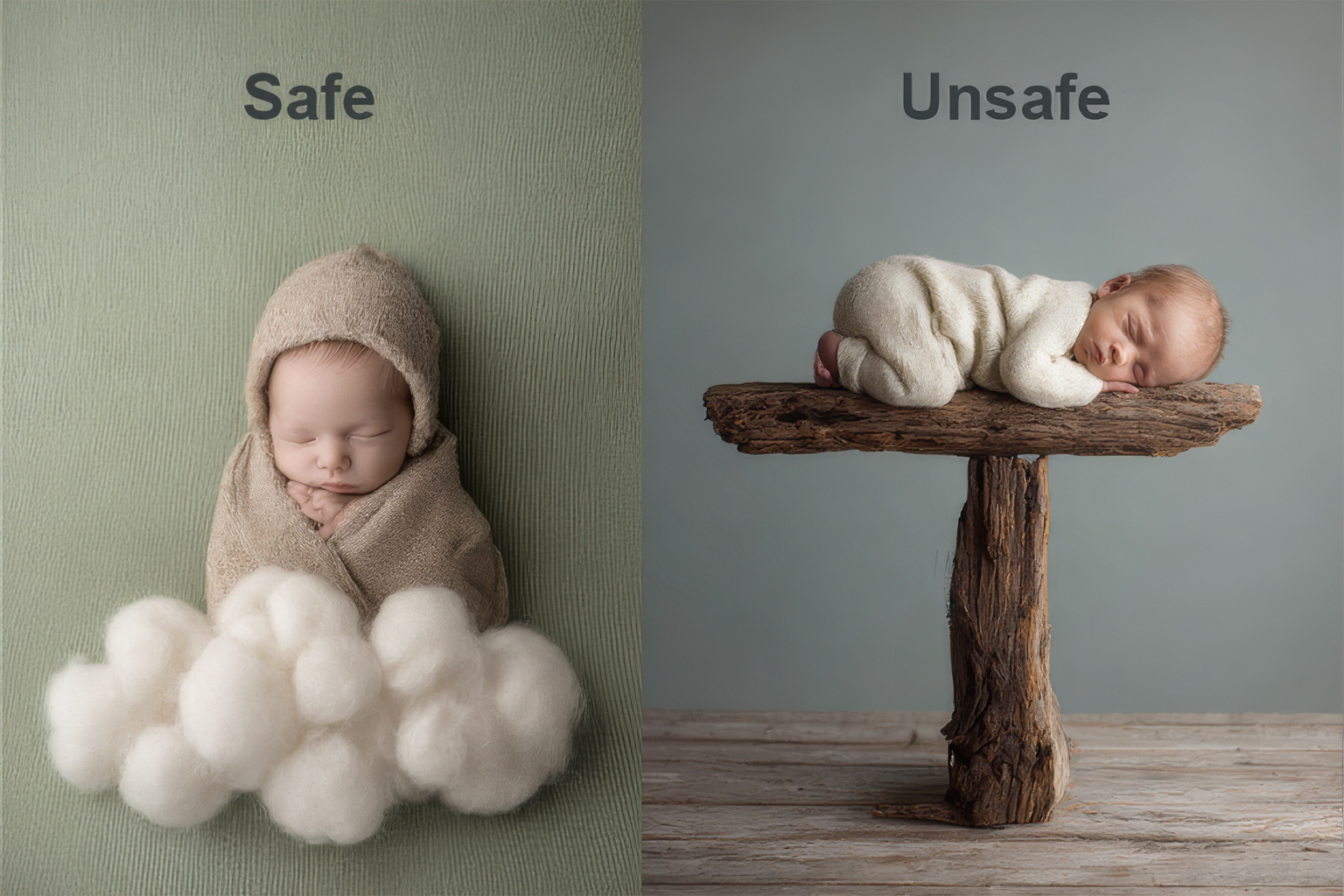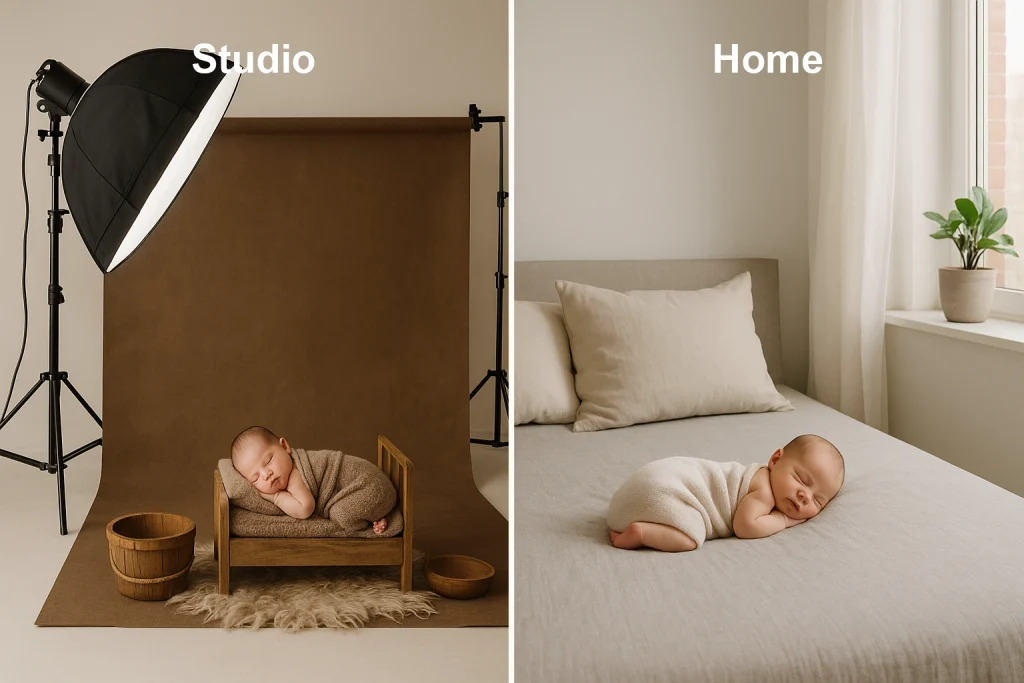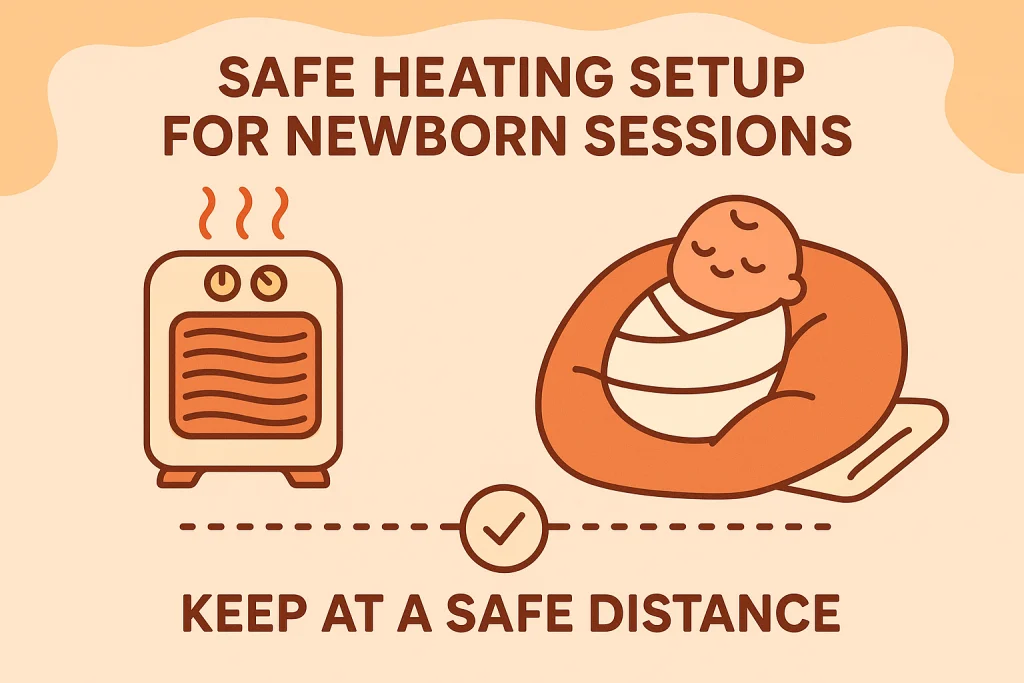Introduction
Newborn photography is more than creating beautiful keepsakes—it’s about doing so in a way that keeps your baby safe and comfortable. Because newborns are so tiny, delicate, and unable to support themselves, newborn photography safety must always come first. This checklist will help you know exactly what to look for, what to ask, and how to prepare before stepping into the studio. Think of it as your guide to a safe and stress-free experience.
Before the Shoot: Preparation & Choosing a Photographer
Credentials & Training
Not all photographers are trained in newborn posing. Ask:
- Have they completed newborn safety training?
- Do they know how to spot safe vs. unsafe poses?
- Are they insured?
A professional with safety training will know how to handle your baby with the gentleness and patience they need.

Portfolio & Safe Posing
When reviewing a photographer’s portfolio, look beyond the cuteness factor. Check that:
- The baby’s head and neck are supported.
- Props look stable and secure.
- Tricky poses like the “froggy pose” are composites (digitally merged), never forced.

Communication & Expectations
Before booking, chat openly with your photographer. Discuss:
- Your comfort level with certain poses.
- Feeding or soothing breaks.
- Your baby’s unique needs (prematurity, reflux, etc.).
Open communication sets the stage for a session where your baby’s safety is never compromised.
When & Where: Timing & Environment
The setting and timing of your newborn session play a huge role in both safety and comfort. Choosing the right moment and environment can mean the difference between a calm, relaxed baby and a stressful shoot.
Best Time for Newborn Photos
- First 5–14 days: Most photographers recommend this window because babies are sleepier, curl naturally, and are more tolerant of gentle posing. Their startle reflex is still strong, but they’re easier to soothe back into slumber.
- Beyond two weeks: Babies may be more alert, less flexible, and fussier, which means different posing styles—more wrapped, cuddly poses or parent-involved shots—may be better suited.
- Scheduling tips: Avoid booking right after doctor visits or vaccinations, as babies may be uncomfortable. Choose a time of day when your little one is usually calmest.
Studio or At-Home Setup
Both options can be safe, but each has different considerations:

- Studio sessions:
- Professional studios are usually prepped for newborns with controlled temperature, sanitized props, and professional lighting.
- Ask about the studio’s cleaning routine—are blankets washed between every session? Are props disinfected?
- Ensure the studio has enough space for parents to sit, feed, or relax while the baby is being photographed.
- At-home sessions:
- Babies are often more comfortable in familiar surroundings, and parents may feel more relaxed.
- Make sure the photographer brings sanitized props, safe backdrops, and lighting that won’t overwhelm the baby.
- Clear floor space of clutter and pets to reduce risks of tripping or sudden distractions.
Temperature & Climate Control

- Babies cannot regulate their body temperature well. Studios should maintain a cozy warmth (25–28°C), but not so hot that baby overheats.
- Photographers often use small heaters near the posing area. These should never blow directly onto the baby and should always be monitored.
- In at-home sessions, check for drafts or cold spots. Avoid ceiling fans or open windows near the baby.
Environment & Air Quality
- Babies are sensitive to scents and allergens. Avoid candles, incense, or strong perfumes in the shooting space.
- Ensure the air is clean—no dust, mold, or pet hair near props and blankets.
- Natural light is wonderful, but if windows are open, confirm the area is insect-free and safe.
Accessibility & Safety for Parents
- If your session is at a studio, check location convenience. Does it have easy access for strollers? Parking nearby? In Artin Photography’s case, being near Moody Centre Station in Port Moody means families can even arrive by SkyTrain or West Coast Express.
- Ensure the space has comfortable seating, nursing-friendly corners, and diaper-changing surfaces.
By planning the right timing and ensuring the environment is safe, clean, and comfortable, you create the foundation for a calm session where your baby’s wellbeing comes first.
Props, Poses, and Physical Safety
Safety during posing and prop use is one of the most important parts of newborn photography. Many of the iconic shots you see online are only safe when done correctly. Here’s how to make sure your baby is always protected:
Safe Posing
- Head and neck support: A newborn’s head is heavy compared to their body. Always ensure that either a parent, assistant, or hidden support is in place.
- Never force a pose: If your baby resists, cries, or seems uncomfortable, stop immediately. No photo is worth distress.
- Composite photography: Popular poses like the “froggy pose” (hands under chin) are actually two images merged in editing. If your photographer does this, confirm they use compositing rather than balancing your baby.
- Spotters are non-negotiable: For any elevated or precarious position, an adult’s hand should always be nearby—hands can be edited out later.
Props & Materials
- Stable foundations: Buckets, baskets, bowls, or beds must have weighted bases or sandbags to prevent tipping.
- Material safety: Props should be free of sharp edges, rust, chipped paint, or loose parts that could choke or scratch.
- Fabric care: Wraps, outfits, and blankets should be breathable and soft. Avoid synthetic fabrics that can overheat babies or irritate sensitive skin.
- Sanitation: Every prop must be cleaned between sessions. Babies often mouth fabrics or suck on their hands while wrapped.
- Natural vs. themed props: Cute seasonal props (pumpkins, flowers, wooden crates) can look beautiful, but they must be clean, pesticide-free, and properly lined for safety.
Surfaces & Height Safety
- No unattended moments: Babies should never be left alone on props, beanbags, or beds, even for a second.
- Floor setups preferred: Many safe poses happen close to the ground, where padding and blankets reduce any risk if baby moves.
- Padding is essential: Place soft padding under every prop. Even if it looks stable, hidden cushioning provides an extra layer of safety.
- Height awareness: If elevated props are used, confirm the photographer has someone holding or spotting. Some photographers fake height using clever angles and editing, which is safer than the real thing.
Red Flags to Watch For
Parents should feel empowered to speak up if they notice:
- A baby being balanced or propped up without support.
- A photographer walking away while the baby is on a prop.
- Use of glass containers, rough wood, or fragile items.
Remember: no shot is worth a risk. The most timeless images come from sessions where the baby feels secure, calm, and comfortable.
Comfort: Temperature, Lighting & Material Sensitivity
Comfort is the cornerstone of newborn photography. A baby who feels safe, warm, and relaxed is more likely to settle into those dreamy poses parents love. Creating that comfort requires paying close attention to temperature, lighting, and the materials used throughout the session.
Room Temperature & Baby Comfort
- Warmth is key: Babies can’t regulate body heat. The room should feel almost tropical to adults but perfectly cozy for a lightly dressed newborn. Around 25–28°C is ideal.
- Heaters and blankets: Portable space heaters or heating pads (under blankets, never directly under baby) are commonly used to maintain warmth. They should always be monitored to avoid overheating.
- Reading baby’s cues: Signs of being too warm include flushed cheeks, sweating, or fussiness. Signs of being too cold include mottled skin, bluish hands/feet, or shivering.
- Layering: Have extra wraps and blankets nearby so adjustments can be made quickly without long interruptions.
Lighting Choices
- Gentle illumination: Soft, diffused light is best for newborns, mimicking the natural glow of daylight. Harsh spotlights or strong flashes can startle or irritate babies.
- Flash use: Occasional flash is not harmful when used properly and bounced or diffused, but direct strobe lighting close to a baby’s eyes should be avoided.
- Natural light: Large windows with sheer curtains create flattering light and reduce the need for artificial sources.
- Calming environment: Bright, flashing lights can be overwhelming. Lighting should feel serene, not clinical.
Fabrics, Wraps & Skin Safety
- Breathable fabrics: Cotton, bamboo, or soft knits allow airflow and prevent overheating.
- Avoid irritants: Rough lace, sequins, or synthetic materials can scratch or irritate delicate skin.
- Fit matters: Wraps should be snug enough to provide security but loose enough for baby to breathe and move. Restrictive wrapping around the chest or neck is unsafe.
- Accessories caution: Headbands, hats, or decorative props should never press into baby’s skin or cover airways. Always remove accessories as soon as they cause redness or irritation.
- Allergy awareness: Wash wraps and outfits with fragrance-free detergent, and ask parents if their baby has known sensitivities.
Sensory Comfort
- Sound: White noise or gentle shushing can help calm babies, masking background noises.
- Touch: Gentle handling, soft fabrics, and slow movements reduce startle reflex.
- Smell: Avoid perfumes, scented candles, or laundry detergents with heavy fragrances—babies thrive in neutral environments.
Creating the right balance of warmth, gentle light, and soft textures ensures that the baby remains comfortable and safe, setting the stage for peaceful, timeless photographs.
Health & Hygiene Considerations
Clean & Sanitized Equipment
Ask your photographer:
- Are blankets washed between sessions?
- Are props disinfected?
- Do they sanitize their hands before touching your baby?
Photographer / Staff Health
If the photographer is sick, reschedule. Babies’ immune systems are fragile—safety first.
Parent Role in Hygiene
Bring extra diapers, wipes, and a change of clothes for both baby and yourself. Accidents happen—it’s part of the journey!
During the Session: What to Watch Out For
The actual session is where all the preparation and planning come together. Parents often wonder what’s “normal” and what should raise concern. Here’s what to keep an eye on while your little one is in front of the camera.
Monitoring Baby’s Signals
- Breathing: Babies should always breathe freely, with no wrap or hand covering their nose or mouth. If you notice shallow or strained breathing, speak up immediately.
- Skin tone: Healthy skin tones range from pink to slightly rosy. If you notice pale, bluish, or mottled skin, the baby may be too cold or uncomfortable in their position.
- Body language: Stretching, flailing, or stiffening may mean discomfort. Squirming during posing can signal that the position isn’t safe or cozy.
Breaks, Feeding, Soothing
- Regular breaks: Expect pauses every 30–45 minutes for feeding, burping, or soothing. A good photographer builds these into the schedule rather than rushing through.
- Parent involvement: Don’t hesitate to feed, cuddle, or change your baby when needed. A session is never a race—it’s a flow that follows your baby’s needs.
- Cues for soothing: Some babies respond to gentle rocking, swaddling, or white noise. Experienced photographers often have tricks to calm babies but will always defer to the parent’s methods.
Avoiding Overexposure & Fatigue
- Session pacing: Newborn sessions can last 2–4 hours, but much of that is downtime. If the baby seems restless, it’s better to extend breaks than force poses.
- Limiting overstimulation: Keep the environment calm—avoid loud chatter, multiple bright light sources, or sudden movements.
- Respecting limits: Not every baby will do every pose, and that’s okay. A photographer who insists otherwise isn’t prioritizing safety.
Parent’s Role During the Session
- Stay close and attentive—you’re the ultimate safety net.
- Ask questions if you feel unsure about a pose or prop.
- Provide comfort when your baby needs familiar touch, scent, or voice.
A safe session is collaborative. The photographer may guide the flow, but parents are partners in keeping the baby calm, comfortable, and secure.
After the Shoot & Photo Editing Safety
Safe Storage of Digital Files
Trustworthy photographers protect your images with secure storage and backups.
Post-Processing Transparency
Some magical poses are created by merging two photos together. This ensures baby safety. Ask if composites were used when you see complex poses.
Displaying Photos at Home
When framing, use shatter-proof glass and hang frames securely—because safety extends to your home, too.
Newborn Photography Safety Checklist (Printable)
Before booking, ask your photographer:
- What newborn safety training have you completed?
- Do you carry liability insurance?
- Will you always support the baby’s head and neck?
- Are tricky poses done as composites?
- How are props sanitized?
- What’s the studio temperature?
- Can I be present as a spotter?
- Do you reschedule if you’re unwell?
- How do you monitor baby cues during the shoot?
Conclusion
Safe sessions aren’t just about avoiding risks—they’re about creating an environment where your baby can relax, and you can trust the process. By following this checklist, you’ll not only get timeless portraits but also peace of mind. After all, safety is the most beautiful backdrop for every newborn photo.
Draft v1 is in Canvas—highlight text or comment for tweaks.
FAQ
Why is newborn photography safety important?
Newborn photography safety keeps the baby well and comfy during the shoot. Parents then feel their baby is safe.
How can I choose a photographer focused on safety?
Look at their photos to see their experience with newborns. Ask how they ensure the baby’s safety.
Why is clear communication about my vision important?
Clear communication helps the photographer get your style and the safe poses you want for your baby. It makes the shoot safe and fun.
What should I consider when setting the scene for the newborn shoot?
Think about the shoot location. Make sure it’s clean and safe.
Consider the light, warmth, and noise to keep your baby calm and safe.
When is the best time to schedule a newborn session?
The best time for a newborn session is within the baby’s first 14 days. Babies sleep well then, making safe posing easier.
How can I create a safe set for the newborn shoot?
Keep the area warm and use safe props. Clear away dangerous items. Have someone help to keep the baby safe while posing.
Are there any specific guidelines for newborn posing and handling?
Yes. Always support the baby’s head and neck. Move gently and avoid strain on the baby’s body. Keep the baby’s safety first.
What are composites, and how do they contribute to newborn photography safety?
Composites blend images to safely get cute shots without risky poses. This method keeps the baby safe while capturing great photos.
What essentials should I bring to my newborn’s photo session?
Bring snacks, extra baby clothes, feeding gear, and any special items. Don’t forget diapers, wipes, and something to calm the baby.
How do I balance style and comfort when selecting outfits for a newborn photo session?
Choose comfy, soft clothes for your baby first. Then, think about matching the family’s outfits for a good look.
How can I ensure ongoing safety with the newborn photographs?
Keep photos out of baby’s reach. Check on the baby’s well-being after the session. Display the photos in a safe place.

